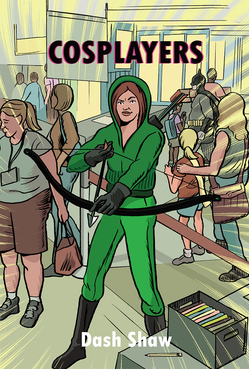
Writer/Artist: Dash Shaw
Publisher: Fantagraphics
Release Date: September 6, 2016
 If you Google “cosplayers,” the autocomplete suggestions are, in order, “cosplayers snapchat,” “cosplayers are annoying,” “cosplayers among us,” “cosplayers told to cover up” and “cosplayers without makeup.” That combination of annoyance and fascination is probably what characterizes most perceptions of the folks who dress up like their favorite comics, anime and movie characters. It’s not, however, what Dash Shaw is really getting at in this collection of his shorter work on the subject. This slim book is not a work of anthropology, so it doesn’t anatomize or explain. Rather than being about cosplayers in general, it’s about a specific group of characters who aren’t intended as emblems of their fellow dress-up enthusiasts.
If you Google “cosplayers,” the autocomplete suggestions are, in order, “cosplayers snapchat,” “cosplayers are annoying,” “cosplayers among us,” “cosplayers told to cover up” and “cosplayers without makeup.” That combination of annoyance and fascination is probably what characterizes most perceptions of the folks who dress up like their favorite comics, anime and movie characters. It’s not, however, what Dash Shaw is really getting at in this collection of his shorter work on the subject. This slim book is not a work of anthropology, so it doesn’t anatomize or explain. Rather than being about cosplayers in general, it’s about a specific group of characters who aren’t intended as emblems of their fellow dress-up enthusiasts.
Shaw started publishing the adventures of Annie and Verti, two young women who engage in cosplay, a couple of years ago, and this collection doesn’t feel like a unified concept so much as a few dips into their world. Rather than spend all their time crafting perfect costumes, they move outward into mass culture, making guerrilla films in which they’re the only people who know they’re acting. Is this cruel? Is it stupid? Is it some kind of statement about kids today? Shaw maintains a blankness on the subject that is studiedly neutral, which probably accounts for some of the popularity of the stories.
Book Trailer for Cosplayers by Dash Shaw. Music by Jesse Moynihan.
The fact that he doesn’t spend time laying things out (i.e., this is what cosplay is) but assumes familiarity with his subject is important, too. It establishes him as an insider rather than an outsider, someone who knows the why and how of the processes and rituals. A literature student could make a case that, in doing so, he draws us into the world of cosplay and makes it our own, which then lets him draw subtle parallels to the ways in which we all costume ourselves. Even when Annie and Verti seem to be wearing ordinary clothing—for example, a page on which Verti puts on the kind of black dress you wouldn’t look at twice, in preparation for her acting debut—the context of what they’re doing identifies it as cosplay, even though it’s worlds away from getting your Harley Quinn on. And if everyday clothes qualify, then all of us are in some way cosplayers, whether getting ready for a date or wearing football team colors on a Friday.
Visually, the book is perhaps less experimental than much of Shaw’s work including Doctors and New School, which makes it more accessible than he can sometimes be. The coloring can feel like Dan Clowes when it moves into pastel shades, but on some pages it has a slick, computer sheen, evoking the bad coloring of many a mainstream superhero book (which is, of course, often what cosplay celebrates). Shaw’s still playing around with overlaid colors, some of which are indeterminate in their meaning, and he jams these pages with information, like the over-stimulating environment of a comics convention. Collage appears occasionally, whether literal or redrawn images, and fine black lines seep outside the panel borders. It’s a bit messy, intentionally, just like the universe it presents and the nature of self-assembled identity. There are plenty of big thoughts like these to sift through while re-reading Cosplayers, but it’s also just a pleasant read—a Bechdel-test-passing, intelligent, well-drawn set of slight stories that maybe have something to say about a very particular time and place.